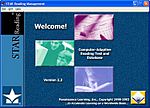STAR (software) facts for kids
  STAR Reading and STAR Early Literacy (blue) and STAR Math (green) logos. |
|

"Splash screen" for "STAR Reading Management," the teacher/administrator access to STAR Reading, version 2.3 for Microsoft Windows.
|
|
| Developer(s) | Renaissance Learning |
|---|---|
| Stable release |
STAR Math 2.1.3, STAR Reading 2.4.2
|
| Operating system | Windows, Mac |
| Type | Educational |
STAR Reading, STAR Early Literacy, and STAR Math are special tests for students in kindergarten through 12th grade. They are made by a company called Renaissance Learning. These tests are "computer-adaptive," which means they change based on how you answer. If you get a question right, the next one might be a bit harder. If you get it wrong, the next one might be a bit easier. This helps the test figure out your skill level quickly.
These STAR tests help teachers understand how much students are learning. They are different from big, important tests that decide if you pass a grade. They are also different from quick checks teachers do every day.
Contents
What Are STAR Assessments For?
STAR assessments give teachers important information about how students are growing and what they have learned. Students take the tests, and the computer scores them right away. Teachers and school leaders can then look at reports for individual students, whole classrooms, or even entire grades. This helps them decide what to teach next and how to help each student.
Types of STAR Assessments
Each STAR assessment helps estimate a student's skills. It also compares a student's abilities to other students across the country. This feedback helps schools plan lessons and activities. The software can show things like your "grade equivalent," which means the grade level where your skills are typical.
All STAR tests are now mostly available online through a system called Renaissance Place.
STAR Reading
STAR Reading checks how well students read. It gives an idea of a student's reading level. The company says students can finish this test in less than 10 minutes.
STAR Early Literacy
STAR Early Literacy helps assess skills for very young students, from pre-kindergarten to third grade. It checks if they are ready to read. This test helps identify reading levels, like "Emergent Reader." Students can usually finish this test in less than 10 minutes.
STAR Math
STAR Math measures students' math skills. It gives an idea of a student's math level. This test usually takes less than 12 minutes to complete.
STAR Spanish
STAR Spanish checks how well students understand Spanish reading. It's for students in grades 1-5, but older Spanish-speaking students (up to grade 12) can also take it. STAR Spanish helps track a student's Spanish reading level and how much they are improving.
How Accurate Are These Tests?
When we talk about how "reliable" a test is, we mean if you would get a similar score if you took the test again soon after. "Validity" means if the test actually measures what it's supposed to measure.
Many studies have shown that STAR Reading, STAR Math, and STAR Early Literacy are reliable and valid. This means they generally give consistent results and measure reading or math skills well. Like any test, your score might be a little different each time you take it. This is normal and is called "measurement error."
Outside groups, like the National Center on Student Progress Monitoring, have looked at STAR products and found them to be good tools.
Some Concerns
In 2005, the Illinois State Board of Education (ISBE) said they would not use STAR Reading scores to measure reading progress for a specific grant. However, they still allowed schools to use STAR Reading to help make teaching decisions. Since then, the ISBE has updated its information and now considers STAR Reading a good way to assess reading comprehension.
See also
- Accelerated Reader
- Accelerated Math

